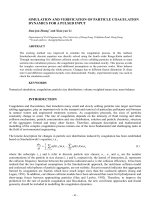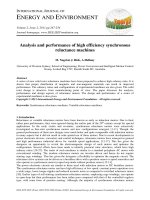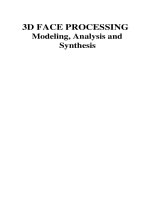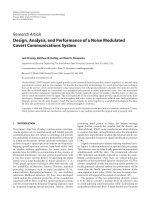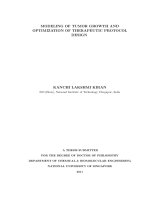Modeling, analysis and verification of optimal fixture design
Bạn đang xem bản rút gọn của tài liệu. Xem và tải ngay bản đầy đủ của tài liệu tại đây (869.27 KB, 81 trang )
MODELING , ANALYSIS AND VERIFICATION
OF OPTIMAL FIXTURE DESIGN
ERNEST TAN YEE TIT
B. Eng (Mech.), NUS
A THESIS SUBMITTED
FOR THE DEGREE OF MASTER OF ENGINEERING
DEPARTMENT OF MECHANICAL ENGINEERING
NATIONAL UNIVERSITY OF SINGAPORE
2003
ACKNOWLEDGEMENTS
I am very grateful to the following from whom I received help and guidance for this
research:
1. A/Prof A. Senthil kumar for his valuable direction, insight and giving me the
opportunity to complete my research under him.
2. A/Prof Jerry Y. H. Fuh for his precious time, concern and valuable guidance.
3. Mr Vincent Ling Yun and Mr Kevin Lim Heng Tong, final-year students, for their
contribution in this research. Without them this research would not have been
successful.
4. Dr. Lim Han Seok for his expertise and help in developing the experimental force
sensor system.
5. Mr Lim Soon Cheong who helped me arrange for the experiments.
6. Staff at Workshop 2 who helped produce the fixtures and sensor bodies.
i
TABLE OF CONTENTS
Acknowledgements .............................................................................................................i
Table of Contents ...............................................................................................................ii
Summary.............................................................................................................................v
List of Figures....................................................................................................................vi
List of Tables ...................................................................................................................viii
List of Symbols ..................................................................................................................ix
Chapter 1.
Introduction................................................................................................1
1.1
Background.............................................................................................................1
1.2
Literature survey.....................................................................................................1
1.3
Objectives ...............................................................................................................6
1.4
Organization of the Thesis......................................................................................6
Chapter 2. Automatic Selection of Clamping Surfaces and Positions using the
Force Closure Method .......................................................................................................7
2.1
Theory of Force Closure.........................................................................................7
2.1.1
2.1.2
2.2
Stages of implementation .....................................................................................12
2.2.1
2.2.2
2.2.3
2.2.4
2.2.5
2.2.6
2.3
Force model .....................................................................................................7
Convex hull algorithm .....................................................................................9
Inputs..............................................................................................................13
Marking off unavailable grid points on the base plate...................................13
Identify candidate clamping surfaces.............................................................13
Generate spiral mesh......................................................................................14
Visualization ..................................................................................................16
Clamp Sequencing .........................................................................................17
Summary...............................................................................................................18
Chapter 3.
Modeling of Minimum Clamping Force ................................................19
ii
3.1
Introduction ..........................................................................................................19
3.2
Optimization Equations ........................................................................................19
3.3
Example ................................................................................................................21
3.4
Summary...............................................................................................................22
Chapter 4.
Experimental Force Sensor.....................................................................23
4.1
Working Principle of the Sensor ..........................................................................24
4.2
Visual Basic Data Acquisition Program...............................................................27
4.3
Software Requirements.........................................................................................29
4.4
Calibration of Sensors ..........................................................................................29
4.5
Evaluation of Sensor Performance .......................................................................30
4.6
Summary...............................................................................................................31
Chapter 5.
Finite Element Modeling of the Workpiece-Fixture Setup..................32
5.1
Description of the Developed FEM model...........................................................32
5.2
Comparison Study ................................................................................................33
5.2.1
5.2.2
5.3
Model 1 - Mittal’s FEM Model .....................................................................34
Model 2 - Tao’s FEM Model .........................................................................38
Summary...............................................................................................................43
Chapter 6.
Experimental Verification of the Finite Element Model......................44
6.1
Instrumentation.....................................................................................................44
6.2
Stiffness Test ........................................................................................................45
6.3
Description of Case Study 1 .................................................................................47
6.4
Results & Discussions of Case Study 1................................................................51
6.5
Description of Case Study 2 .................................................................................55
6.6
Results & Discussion of Case Study 2 .................................................................58
Chapter 7.
Conclusions and Recommendations.......................................................63
iii
7.1
Conclusions ..........................................................................................................63
7.2
Recommendations ................................................................................................64
References.........................................................................................................................66
Appendix.......................................................................................................................... A1
iv
SUMMARY
Fixture design is an important manufacturing activity which affects the quality of parts produced.
In order to develop a viable computer aided fixturing tool, the fixture-workpiece system has to be
accurately modeled and analysed. This thesis describes the modeling, analysis and verification of
optimal fixturing configurations by the methods of force closure, optimization, and finite element
modeling (FEM). Force closure has been employed to find optimal clamping positions and
sequencing, while optimization is used for determining the minimum clamping forces required to
balance the cutting forces. The developed FEM is able to determine in detail what are the reaction
forces, workpiece displacement, deformation in the workpiece and fixtures. In order to produce a
more accurate model for predicting the behaviour of the fixture–workpiece system, the developed
FEM includes fixture stiffness, while past models have assumed as rigid bodies.
The reaction forces on the locators are experimentally verified. A sensor-embedded experimental
fixturing setup was developed to verify the modeling and the data was used to compare with the
FEM. Two case studies were conducted and compared in the experiment and in FEM. As a
secondary objective, a prototype fixture-integrated force sensor was developed for use in the
experiment. But it was insufficiently reliable at this stage and the measurement of reaction force fell
back upon the existing Kistler slimline force sensor. It was found that the FEM-predicted reaction
forces trends match well with the experimental data. Therefore this improved finite element model
allowing room for slight error could be used to simulate the behaviour of an actual
fixture-workpiece system during machining.
v
LIST OF FIGURES
Figure 1.1. Framework of Computer-Aided Fixture Design ...............................................2
Figure 2.1. Approximation of Friction Cone for Contact Ci ...............................................9
Figure 2.2. Spiral Mesh of clamping surface to find candidate clamping points ..............15
Figure 2.3. Colour Map of Side Clamping Surfaces based on rmax. (Blue is the optimal area
and red is the infeasible area.).....................................................................................16
Figure 2.4. Colour Map of Top Clamping Surfaces based on rmax. (Blue is the optimal area
and red is the infeasible area.).....................................................................................17
Figure 3.1. Minimum clamping force required vs time predicted by optimization algorithm.
.....................................................................................................................................22
Figure 4.1. Sensor integrated fixture-workpiece system ...................................................23
Figure 4.2. The structure of the sensor ..............................................................................24
Figure 4.3. Uniform load over a small central area of radius r0, edge simply supported. .25
Figure 4.4. Side view of the sensor showing the air gap between the cap and brass plate.
.....................................................................................................................................26
Figure 4.5. Circuit and output connection of the sensor....................................................26
Figure 4.6. Frequency output of the sensor. ......................................................................27
Figure 4.7. Instrumentation Layout ...................................................................................29
Figure 5.1. Model 1 after meshing (With reference to Mittal’s model). ...........................34
Figure 5.2. Fixturing layout for model 1............................................................................35
Figure 5.3. Machining profile for model 1 ........................................................................35
Figure 5.4. Reaction force vs time chart obtained by Mittal. ............................................37
Figure 5.5. Results from finite element analysis................................................................37
Figure 5.6. Model 2 after meshing (With reference to Tao’s Model). ..............................39
Figure 5.7. Fixture layout and location for model 2 ..........................................................40
vi
Figure 5.8. Reaction force vs time obtained in Tao’s experiment. ....................................41
Figure 5.9. Finite element results for Tao’s model (without fixture element stiffness). ...42
Figure 5.10. FEM results from developed model (with fixture element stiffness)............42
Figure 6.1. Schematic of the Fixture Stiffness Test...........................................................45
Figure 6.2. Relationship of force applied vs deflection on supporting element. ...............46
Figure 6.3. Relationship of force applied vs deflection on locating elements...................47
Figure 6.4. Modeling of the workpiece and locations of clamps/locators for Case Study 1.
.....................................................................................................................................48
Figure 6.5. Experimental Setup for Case Study 1..............................................................49
Figure 6.6. Typical dynamic force obtained from experiment. Reaction force is shown at
locator 7.......................................................................................................................50
Figure 6.7 A graph of reaction forces of supports and locators vs time of Case Study 1..53
Figure 6.8 A graph of reaction forces of clamps vs time of Case Study 1. .......................54
Figure 6.9. Experimental Setup for Case Study 2..............................................................55
Figure 6.10. Dimension of workpiece and locations of clamps/locators of Case Study 2.57
Figure 6.11. A graph of reaction forces of locators and supports vs time of Case Study 2.
.....................................................................................................................................61
Figure 6.12. A graph of reaction forces of clamps vs time of Case Study 2. ....................62
vii
LIST OF TABLES
Table 5.1. Comparison of FEM models.............................................................................32
Table 5.2. Modeling Data ..................................................................................................33
Table 5.3. Comparison of features between Mittal’s model and the proposed model.......34
Table 5.4. Modeling data for model 1................................................................................36
Table 5.5. Comparison of features between Tao’s model and the proposed model. .........38
Table 5.6. Modeling data for model 2................................................................................40
Table 6.1. Fixture element stiffness...................................................................................46
Table 6.2. Clamping forces applied in sequence of Case Study 1.....................................49
Table 6.3. Cutting data of Case Study 1. ...........................................................................50
Table 6.4. Clamping forces applied in sequence of Case Study 2.....................................56
Table 6.5. Cutting data of Case Study 2 ............................................................................56
viii
LIST OF SYMBOLS
fik
unit generator of polyhedral friction cone
αik
positive factor for the linear combination of unit generators
ai unit normal of clamping face
µi coefficient of static friction between contact i and workpiece
n
number of contacts
A matrix of facet normals
x
six-dimensional point in the convex hull space
b
vector of facet offsets bi
w six dimensional wrench
fikx, fiky, fikz force components of six dimensional wrench
(ri × fik)x , (ri × fik)y , (ri × fik)z moment components of six dimensional wrench
rmax
radius of maximally inscribed hypersphere
S, T unit direction vectors of clamping surface
ix
Chapter 1. INTRODUCTION
1.1 Background
Today’s advanced flexible manufacturing systems contain CNC machines which can
automatically cut parts and change programs on the fly, move parts between machines
automatically, but when it comes to fixturing, a human machinist is required to accurately
locate and clamp the parts and in some cases design the fixture setup. Surely this is a
bottleneck because of the possibility of human error and long lead time for fixture design,
which is a complex task requiring heuristic knowledge from an expert designer. In
designing a fixture, there are two necessary steps, viz., fixture synthesis and fixture
analysis (see Figure 1.1). Fixture synthesis is supported by a CAD representation system
which has access to a parametric fixture element database. Issues such as the setup and
machining operation, fixture element connectivity, selection of fixturing surfaces and
points are considered in the synthesis process. After conceiving a fixture design using
fixture synthesis methods, it has to be verified through fixture analysis to predict, for
example, whether this configuration is stable or will cause improper contact with the
workpiece during machining, etc.
1.2 Literature survey
Fixture analysis can be categorized into four levels [1], viz., geometric, kinematic, force
and deformation. At the geometric analysis level, spatial reasoning is applied to check for
interference between fixture, workpiece and cutting tool. Kinematic analysis checks for
correct location with respect to datum surfaces (to avoid any over-constrained location)
1
and whether the fixture contacts are positioned adequately to oppose the cutting forces.
The most commonly adopted method of kinematic analysis is force closure.
Framework of Computer-Aided Fixture Design
Fixture Design
Synthesis
CAD Representation
Analysis
Geometric Analysis
Machining Interference
Parametric Fixture Database
Assembly Interference
Fixture Element Connectivity
Kinematic Analysis
Setup Information
Machining Operation
Force Closure
Force Analysis
Minimum Clamping Force
Selection of Fixturing Surface
and points
Bill of Materials
AFD / SFD / IFD
FEM
Deformation Analysis
FEM
Included in thesis
Figure 1.1. Framework of Computer-Aided Fixture Design
Force analysis checks that the reaction forces at the fixture contacts are sufficient to
maintain static equilibrium in the presence of cutting forces. Cutting force profiles need to
2
be known for this level of analysis. Lastly, especially important for flexible parts,
deformation analysis that determines the elastic or plastic deformation of the part under
the clamping and cutting forces. Mittal [2] developed a dynamic model of the
fixture-workpiece system that is able to describe the elastic effects of fixture-workpiece
contacts, the position, velocity and acceleration of all bodies involved, and the reaction
forces. De Meter[3] developed a linear model for predicting the impact of locator and
clamp placement on workpiece displacement throughout the machining operation and
determining whether the clamping forces are adequate to constrain the part during
machining. Li and Melkote[4] developed a general method for iteratively optimizing the
fixture layout and clamping forces while accounting for workpiece dynamics. The finite
element method (FEM) for fixture analysis has been described in [5] and [6].
Friction plays a dominant and beneficial role in the fixture-workpiece interaction. A
workpiece can be totally restrained by as few as two large contacting surfaces because of
friction, as in a vice. Damping of cutting forces is partly attributed to interfacial friction
between the fixture and workpiece. Therefore it is important to include the frictional
effects in a fixture-workpiece model.
For fairly rigid workpieces, machining forces on the workpiece could cause local elastic
deformations at the points of contact between the locators and clamps, resulting in
workpiece locating error. This is known as contact deformation, and contact stiffness
plays a major role in such a deformation. The ABAQUS/CAE FEM package is able to
model Coulomb frictional contact between the elastic “master” and “slave” surfaces,
3
where the “master” surface is defined as the more rigid one of the two. These are modeled
using the contact mechanics theory in partial differential equations defining stress and
elastic strain within the contact pair.
Fixture stiffness has been studied by Rong & Zhu [7]. The deformation of fixture
components and their connections may significantly contribute to machining inaccuracy
of parts and dynamic instability during the machining process. Some factors that affect
fixture stiffness are: fastening force magnitude and the orientation of the fixture
components. The most direct way of determining fixture stiffness is to apply a load to the
fixture assembly and measure the deflection at various points. This gives a deformation
curve, where the stiffness is the gradient. The problem with experimentally determining
the fixture stiffness is that almost infinite combinations of assemblies are possible. This
stiffness is modeled in FEM using a spring element which is placed normal to the
direction of the fixture contact surface.
In this research, the fixture element in the FEM model is modeled as deformable rather
than rigid, which previous researchers have done. One goal of fixture design is to make
the fixture as rigid as possible. However, real fixtures have finite stiffness. Based on
stiffness tests on fixture elements, the stiffness of the locators used is kL = 3.24 x 107 N/m,
which is less stiff than the workpiece. The stiffness of the rectangular workpiece
described in Figure 6.5 is as follows, kz = 2.97 x 1010 N/m, ky = 4.56 x 1010 N/m and kx =
1.14 x 1010 N/m. Clearly in this case, the less stiff fixture would deform much more than
the workpiece when subjected to the same force. Generally, modular fixtures are not as
4
rigid as dedicated fixtures, and it is common to see stacking of fixture components, which
reduces the overall stiffness. Including the effect of fixture stiffness in the FEM would
make a difference in cases where the fixture is less stiff than the workpiece.
From a comparison of Tao’s FEM model which does not include fixture stiffness and
the developed FEM model, it was found that when the effect of fixture stiffness is
included into the model, the reaction forces of the analysis are slightly lower than the one
without the fixture stiffness. This comes to a conclusion that the reaction forces are
lowered with the introduction of the fixture stiffness. Therefore the developed FEM
model with fixture stiffness is in fact a safer prediction, leading to higher clamping
intensity required to keep the workpiece stable.
The model is built to simulate the actual physical reaction of a fixturing system and
hence to foresee any potential error in the design. Various engineering properties that
govern the accuracy of the analysis are included into the model. These properties are:
•
Contact stiffness,
•
Stiffness of locators, clamps and workpiece (element stiffness), and
•
Frictional force between contact surfaces
Previous research works on fixture design have never included all the above-mentioned
properties into a single experiment or analysis. Thus, the major aim of this project is to
develop a modeling method that includes all the real time conditions that present in an
actual set up of a fixture-workpiece system.
5
1.3 Objectives
The research undertaken involved (1) the use of the force closure method to predict
optimal clamping positions and clamping sequence, (2) using an optimization algorithm
to predict the reaction forces at the fixture contacts, and (3) development of an FEM
model of the fixture-workpiece system that includes fixture stiffness. The force closure
method generates a set of optimal clamping positions based on pre-selected locating and
supporting positions. The optimization algorithm predicts the minimum reaction forces at
the fixture contacts under the external cutting forces and moments. Lastly, the developed
FEM model describes the workpiece and fixture contacts as deformable and interacting
with each other by Coulomb frictional contact. The cutting process is simulated using a
quasi-static cutting force and moment applied along the tool path. To verify the FEM
model, reaction forces predicted at the fixture contacts are compared with the readings
from piezoelectric force sensors in the experiment.
1.4 Organization of the Thesis
Chapter 2 explains the theory and implementation of the force closure method in
automated fixture design, AFD. Chapter 3 discusses an algorithm for the non-linear
optimization of minimum clamping force in the fixture-workpiece system. Chapter 4 is a
report on the developed experimental force sensor. Chapter 5 explains the details of the
developed finite-element model of the fixture-workpiece system and comparison with
two FEM models by Mittal and Tao. Chapter 6 is an experimental verification of the FEM
model with two case studies. Chapter 7 concludes the thesis.
6
Chapter 2. AUTOMATIC SELECTION OF CLAMPING SURFACES
AND POSITIONS USING THE FORCE CLOSURE METHOD
This section focuses on the selection of optimal clamping points and formulates an
acceptable clamping sequence. Locating and supporting positions and directions have
been automatically selected using the heuristics built in the developed automated fixture
design software[10].
2.1 Theory of Force Closure
Force closure[11] is the balance of forces on the workpiece to determine if static
equilibrium can be achieved. If the applied clamping forces are able to prevent the motion
of the workpiece when it is being acted upon by external machining forces, then there is a
force closure. The fixturing problem is defined by an analytical model which can be
solved mathematically.
The theory of force closure for fixturing is similar to the theory of robotic grasping,
where robotic fingers apply only active forces on an object. In fixturing, only the clamps
apply active forces while the locators and supports are passive elements. Like in a robotic
grasper, friction plays an important part in fixture-workpiece interaction. When a force
model with friction is used, the number of fixturing contacts needed may be reduced.
2.1.1
Force model
Both the contacts and workpiece are regarded as rigid bodies. Each contact is modeled
as an infinite friction cone with the axis along the line of application and zero moment at
the point of contact. Let fi be the contact force acting at the point of contact Ci by the
7
fixture and acting in the direction of the contact normal ai , and let µi be the coefficient of
static friction between the two surfaces. Then fi must satisfy the maximum static friction
condition according to Coulomb’s law[12]:
f i = 1 + µ i2 ( f i ⋅ a i )
for i = 1, 2, ..., n .....................................................
(1)
where n = number of fixture contacts
ai = contact normal
Since fi lies within the infinite friction cone, it is equivalent to a linear combination of
non-negative unit generating vectors bounding the cone. To improve computational
efficiency, this friction cone is approximated by a four-sided polyhedral convex cone
defined by four unit generators (Figure 2.1. ). Since the goal of the force closure method is
to plot a feasible clamping area and based on the need to keep the complexity down, a
four-sided polygonal cone was chosen for this purpose. An increase in the number of
sides of the polyhedral cone improves accuracy but introduces increased complexity that
is not justifiable by the purpose of the algorithm.
8
ai surface normal
fi3
fi2
fi4
fi1
tan-1µ
R
ri
P
Figure 2.1. Approximation of Friction Cone for Contact Ci
4
f i = ∑ λik f ik λik ≥ 0 for k = 1, 2, 3, 4 ......................................................................(2)
k =1
where k = index of each unit generator
λik = scalar factor for each unit generator
To find the unit generators, fik, the following vectors are calculated. Find fi1 by rotating
ai by angle tan-1µ about the unit vector RP on the plane of the contact surface. Rotate fi1
about ai by 90° to get fi2. Rotate fi1 about ai by 180° to get fi3 . Rotate fi1 about ai by 270°
to get fi4. Note that each unit generator is represented by a wrench which has six
coordinates.
2.1.2
Convex hull algorithm
For the purpose of determining the clamping stability of a clamping point and clamping
9
direction, it was assumed that the fixture elements contact the workpiece at seven points,
namely, three locators, three supports and one clamp which gives a total of seven
contacts. Seven points of contact are used because the model and experimental fixtures
are based on 3-2-1 locating principle with the seventh contact as the first clamping force
required to arrest all the degrees of freedom. In the frictionless case, four and seven
contacts are necessary to achieve force closure for 2-D and 3-D parts respectively. For the
frictional case, three contacts are sufficient for 2-D and four are adequate for 3-D parts
[13]. The actual configuration allows for more than one clamp. Each contact has four unit
generators (square polyhedral cone). Therefore the total number of λik unknowns is 28 (7
x 4). Note that each unit generator is a six-dimensional wrench.
This problem is solved using a class of multi-dimensional geometric methods known as
convex hull algorithms. Among the convex hull algorithms, the Quick Hull Algorithm
developed by the Geometric Center [14] is available in C library source code and is
implemented to solve the fixturing problem.
The primitive (unit) wrench of a unit generator is defined as
[
wik = fikx fiky fikz (ri × fik)x (ri × fik) y (ri × fik)z
Where
]
T
............................................ (3)
r = position vector of the contact point with respect to the origin
The bounding (total) wrench of a contact is defined as
w i = λi1 w i1 + λi 2 w i2 + λi 3 w i3 + λi 4 w i4
...................................................................(4)
where λik ≥ 0 for k = 1, 2, 3, 4
Twenty-eight rows of input points (six-dimensional wrenches) are computed from the
given fixturing positions and directions producing the matrix A. This is written to the
10
input file for the QuickHull algorithm, i.e.
⎛
⎜
⎜
⎜
A=⎜
⎜
⎜
⎜
⎜
⎝
f11x
f12x
f11y
f12 y
f11z
f12z
f13x
f13y
f13z
f14x
f14 y
f14z
:
:
:
f 74x
f 74 y
f 74z
(r1 × f 11 )x (r1 × f 11 )y (r1 × f 11 )z ⎞
⎟
(r1 × f 12 )x (r1 × f 12 )y (r1 × f 12 )z ⎟
(r1 × f 13 )x (r1 × f 13 )y (r1 × f 13 )z ⎟
⎟
(r1 × f 14 )x (r1 × f 14 )y (r1 × f 14 )z ⎟ ..........(5)
⎟
:
:
:
⎟
(r7 × f74 )x (r7 × f74 )y (r7 × f74 )z ⎟⎠
where A is a ‘28 x 6’ matrix of facet normals.
For this fixturing application, the specific convex hull is defined such that all points, x,
inside the convex hull must satisfy:
Ax + b ≤ 0 ............................................................................................................ (6)
where x = [ x1 x2 x3 x4 x5 x6 ]T is a six-dimensional point in the convex hull space
b = [b1 b2 b3 …b28]T is a 28 component vector of facet offsets from the convex
hull origin (a convex hull is made up of facets)
Each candidate clamping position is associated with a different matrix A. The
QuickHull algorithm computes the vector b from A. The vector b is further evaluated by
the program to check for instability and, if considered stable, to compare with other
candidate clamping points for ranking in their stability. The convex hull includes the
origin only if all the normal offset values are non-positive. A clamping point is therefore
said to be feasible when it is able to achieve equilibrium such that the origin is in the
convex hull, i.e. when all bi are negative.
bi ≤ 0
where i = 1,2,…28 ..................................................................................... (7)
11
By examining the vector b produced by the convex hull algorithm, we can reason about
the stability of the workpiece fixture system as follows:
1. If any bi > 0, the origin must lie outside the convex hull. This means some λιk are
negative, therefore there is non-equilibrium.
2. If all bi < 0, the origin must lie inside the convex hull. This means all λιk are positive,
therefore there is force closure.
3. If one or more offset value bi = 0, the origin must lie on the boundary of the convex
hull. This means that one or more λιk are positive, therefore there is marginal equilibrium.
For evaluating the stability of the force closure, the magnitude of rmax is measured. The
radius of the maximally inscribed hypersphere, rmax, defined as the largest hypersphere
from the origin that can fit into a convex hull. This hypersphere has the greatest distance
possible from the origin to the facets of the convex hull. A large distance (rmax) indicates
that the origin is well inside the convex hull and hence the fixturing configuration is more
stable than for one with a small rmax.
rmax =
⎛
⎜
min
⎜
i =1, 2 ,..., 7 ;k =1, 2 , 3, 4 ⎜
⎝
bik
f ikx2 + f iky2 + f ikz2 + (ri × f ik )x + (rι × f ικ ) y + (ri × f ik )z
2
2
2
⎞
⎟
⎟ ............... (8)
⎟
⎠
2.2 Stages of implementation
The following is the sequence of procedures employed to search for optimal clamping
points; starting with defining the inputs and then eliminating the base plate grid points
that are unavailable for use. Candidate clamping surfaces are selected and iterated over in
12
a loop. For each candidate clamping surface, a spiral mesh of candidate points is
generated and tested. It is then presented in a visual form where the feasible points are
coloured according to stability. Lastly the algorithm sequences the clamping by ranking
the clamping surfaces and points.
2.2.1
Inputs
The following are given as input to the system,
•
absolute locating and supporting points, ri
•
normal direction, ai
•
coefficient of static friction, µi , defined as 0.4
•
origin of each candidate face, for calculating the in-plane vector RP.
2.2.2
Marking off unavailable grid points on the base plate
All the grid points under the “shadow” of the workpiece are inaccessible to the
clamping fixtures and these are marked off. Since support grid points are always in the
shadow of the workpiece, hence they are ignored. This is achieved by raising each grid
point on the baseplate vertically by small increments and using the CAD program
function to test whether the point is within the workpiece body. Grid points which tested
true will be those under the workpiece. This method fails when there are holes in the
workpiece, so user interaction is needed to mark off these grid points manually.
2.2.3
Identify candidate clamping surfaces
13
To minimize the computation time, a list of candidate faces for clamping is narrowed
down using the following steps. Firstly, faces to be machined are eliminated because of
cutter collision with fixtures. Secondly, it is a well-known fixturing rule that locating
faces should not be used for clamping, as this would detach the locators from the
workpiece, rendering them useless. Thirdly, as modular fixtures are used, only top and
side faces can be clamped.
2.2.4
Generate spiral mesh
To facilitate testing of all possible clamping points, a mesh at equal intervals on all
possible clamping faces is generated. This task poses a problem of generating these
candidate points despite the irregularities of the planar faces which have curved
boundaries or holes. A spiral search path is used, originating from the centre of the face
for containment computations instead of starting from the corners. Figure 2.2 illustrates
the increasing size of the spiral and shows when the iteration stops. Variables used are
mesh size D = 20 mm, number of loops N, centre point of face and surface unit vectors of
the clamp face S and T.
14
S
T
Figure 2.2. Spiral Mesh of clamping surface to find candidate clamping points
Three consecutive tests, namely the containment test, grid availability test and
Quickhull feasibility test, are performed for each mesh point. Grid availability test and
Quickhull feasibility test will be done only if containment test is first successful. For the
containment test, a CAD program function is called to test whether the mesh point lies in
the bounded plane of the candidate face. The grid availability test involves checking
sixteen neighbouring grid points for availability. If none are available at all, this mesh
point cannot be used for clamping. Lastly the Quickhull feasibility test is performed to
check for force closure for each set of contacts. For each locator and support, values of fik
and ri × fik (bounding wrenches) are computed. These are stored in the QuickHull input
file as input coordinates of the matrix A (eq. 5). For each mesh point, a different matrix A
is computed as input. Then the QuickHull library is called to create a convex hull. An
output file of facet normals and a vector of facet offsets, bi (eq. 7) is given. If all bi are
negative, then this mesh point is feasible. rmax is computed from the output file using eq.8.
Mesh points for each face are sorted according to rmax, in descending order and this is
visualized using Matlab.
15
